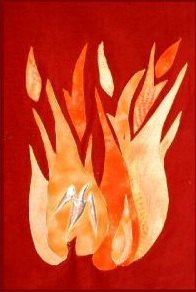 This study guide, as noted at the bottom of the study, is from Barb Murphy, and I’m grateful for her efforts. Maybe this can be of use to you in using The Blue Parakeet: Rethinking How You Read the Bible
This study guide, as noted at the bottom of the study, is from Barb Murphy, and I’m grateful for her efforts. Maybe this can be of use to you in using The Blue Parakeet: Rethinking How You Read the Bible
in your study group.
Thanks Barb.
(By the way, I get the kindest letters from folks who have read BP and I’m grateful for them.)
Chap 1: The book and I
1. Why did Scot tell us his personal story with the Bible?
2. Do you have a personal story with the Bible?
3. What was the big question that Scot discovered?
4. Do you agree that we all “pick and choose”/ adopt and adapt the Bible to our culture?
5. What did Scot learn about how we pick and choose?
6. Why do we need to know the logic behind our picking and choosing?
Chap 2: The Birds and I
1. What’s a blue parakeet represent to Scot?
2. What is reading to retrieve?
a. What are the two kinds
b. What are the problems with this approach?
3. What is reading through tradition?
a. What is the “great tradition?”
b. What is the problem with this approach?
4. What is reading with tradition?
a. Why does Scot call it the third way?
b. How do we do it?
c. What are the dangers?
5. What was Scot’s confession?
How did he find renewal?
6. What is Scot’s motto now?
Can you make it your motto?
7. Complete these statements for yourself
For me the Bible is:
More intimate than __________________________________________
More unusual than ___________________________________________
Has the glory of ____________________________________________
Chap 3: Inkblots and Puzzles–How, then, are we reading?
1. How does Scot describe reading the Bible as story? How would you?
2. Why do we want a shortcut?
3. Let’s describe and discuss the five shortcuts Scot sees? What are the problems with each one?
1. Morsels of Law
2. Morsels of Blessing and promises
3. Mirrors and inkblots
4. Puzzling together the pieces to map God’s mind
5. Maestros
4. Have you tried any of these shortcuts?
Chap 4: It’s a Story with Power!–how, then shall we read?
1. Why does Scot say “context is everything”? Do you have an example?
2. What’s his “seven word secret” and what does he say it reveals about how we’ve learned to read the Bible.
3. Why did he bring up the Dewey Decimal System? What was the bottom line of that discussion?
4. Story of Stephen in Acts 7–why does Scot use this as an example of the right way to read the Bible?
5. What did you learn from the story of Tyndale?
6. What was Scot’s confession in this chapter–why did he explain it to us? What “profoundly profound” realization made him change
7. What is a wiki-story? How is Mathew 4:1-11 used as an example?
8. How do you feel about this book so far? Do you buy what he is saying or does some of it make you feel uncomfortable?
Chap 5: The Plot of the Wiki-stories–how does the Bible work?
1. What three features of a story does the Bible have?
2. What is the basic plot of the Bible? That are the basic themes of the Bible story?
3. What gives the Bible its unity?
4. What does Scot say is the important thing for us to understand about the story of creation in Genesis 1 and 2?
5. What four relationships were “cracked” when Adam and Eve disobeyed in
Genesis 3?
6. What is the giant blue parakeet in the plot of the Bible
What happened to the covenant community?
7. Where is the plot headed?
How does oneness get restored?
8. What four things are accomplished in Christ’s
a. Incarnation
b. Death
c. Resurrection
d. Pentecost
9. How does the story end?
Chap 6: From paper to person–how do we read God’s words?
1. What extraordinary claim do we make about the Bible? What question do we skip over?
2. What’s the difference between a relationship with the Bible and a relationship with the God of the Bible?
3. Discuss the five ideas Scot gives about the relational approach to the Bible:
a. God does not equal the Bible
b. The Bible is God’s communication addressed to God’s people.
c. We are to listen
d. We are in a Big Conversation
e. We are in relationship with God when we listen to his communication.
Chap 7: God Speaks, We listen–What is our relationship to the God who speaks to us in the bible?
1. Why is having the right view of the Bible (inspiration, etc.) not the point of the Bible?
2. What is the point of the parable of the two sons (Matt. 21:28-32)?
3. How is listening connected to loving?
4. Why do words matter? Why does how we respond to words matter?
5. How important are the words “hear” and “listen” in the Bible?
6. What three levels of listening does Scot describe?
7. What does a non-listener look like?
8. What does a listener look like?
Chap 8: the Boring Chapter (on Missional Listening) What does God want to happen to listeners?
1. What’s the “so that” of the Bible story? How do we see this is 2 Tim. 3:14-17?
2. Music Road Hotel’s Fun Water SlideWhat is the mission that God gave the Bible?
3. How is reading the Bible like going down a water slide?
4. What promise makes missional listening powerful?
5. What useful process did God design into the Bible?
6. What are Good works? How do you know if you are reading the Bible aright?
Discerning–How do I benefit from the Bible?
Chap 9: The year of living Jesus-ly–what do we do and what do we not do in the Bible?
1. What boxes (1-10) did you check as commands we should observe?
2. Into what categories do you put the rest of the commands?
3. What about sex before marriage?–were you looking for a definitive answer?
4. How many rules did A.J. Jacobs find? What difficulty would there be in following them all?
5. Does it bother you to “pick and choose” what you apply from the Bible? What’s the only other option?
6. What did you learn from Scot’s three examples?
a. Jesus, prayer, and today
b. Jesus, conversion, and today
c. Jesus, ethics, and today
7. What did you see as the point of this chapter?
Chap 10: Finding the pattern of di
scernment–why do we not follow the Bible sometimes?
1. How would you define discernment?
2. Why does Scot think it is important to understand diversity in the church when we are discussing discernment?
3. Is there any way to avoid the messiness of discernment?
4. What did you learn from the examples of messy discernment?
a. Divorce and remarriage
b. Circumcision
c. Style of Christian women
d. Earth-centered cosmology
e. Death penalty
f. Tongues
g. All things to all
5. Scot says (pg 143) “adaptability and development are woven into the very fabric of the Bible.” Can you embrace a messy view of the Bible like this?
6. What does Scot say we are called to do?
Part 4–Women in church ministry today
Interlude: Scot tells his personal story of how he changed his position on women in ministry–do you have a personal story to tell us on this topic?
Chap 11: The Bible and Women
1. “He who writes the story controls the glory” What does Scot mean when he says: “The Bible was written by men, and the Bible tells stories from the angle of men.”?
Do you find it hard to agree with his premise?
2. What was the prevailing view of women in the Old Testament? How about in the New Testament?
Do you agree that the Church as fossilized this tradition?
3. Let’s discuss the three views that Scot presents. How does he define them and what results do we see in the church today:
a. Hard Patriarchy
b. Soft Patriarchy
c. Mutualism
4. How does the “waterslide analogy” apply to this discussion?
5. Are you looking forward to the next chapters? Did you read ahead?
Chap 12: What did women do in the Old Testament (OT)?
1. Scot labels two kinds of passages/stories in the Bible–what do they mean?
a. WDWD
b. WKSP
2. Why does Scot say: “The church has . . perpetuated the fall as a permanent condition?
3. How does Galatians 3:28 connect to Genesis 1:17?
4. Scot gives us three examples of WDWD in the OT. What did you learn about each one?
a. Miriam: Spiritual leader
b. Deborah: Presidential leade
c. Huldah: Prophet above the Prophets
d. Why do you think he left Ruth and Esther out of this discussion?
Chap 13: What did women do in the New Testament (NT)?
1. Who does Scot claim is the most significant woman in the Bible? Does this surprise you?
2. Scot gives four examples of WDWD in the NT. What did you learn about each one?
a. Mary: a women of influence
b. Junia: an Apostle above other apostles
c. Priscilla: a teacher of scripture and theology
d. Phoebe: a deacon and benefactor
3. How do you feel about this case study so far? Worried? Relieved? Something else?
Chap 14: Silencing the Blue Parakeet (1)
1. How does Scot streamline the debate over 1 Timothy 2:11-12?
2. What is the “theoretical point of enormous significance for women”?
How does Scot describe our fallen condition?
3. What’s “the most important verse about new creation”?
4. What’s the troubling irony of limiting the WDWD passages in light of the WKSP?
5. What is the significance of Pentecost? Acts 2:16-18. How does limiting women’s role contradict the direction of the Bible’s plot?
6. Are YOU surprised by the sudden WKSP in 1 Corinthians 14:34-35?
7. What basics need to be met before someone exercises their gifts in church?
Chap 15: Silencing the Blue Parakeet (2)
1. Why does Scot say “context is everything?”
2. Describe the “new Roman woman.”
3. 1 Timothy 2:9-15–How would Scot apply this WKSP for today?
4. How does 1 Timothy 5:11-14 connect to 1 Timothy 2?
5. What conclusion does Scot draw on page 202? Do you come to the same one?
6. What MUST women do? What’s the principle for today?
7. How does understanding the plot of the whole Bible reveal an increasing expansion of women in church ministries?
8. In light of 1 Corinthians 9:19-23 Scot asks us to toss around this question: “Do you think Paul would put women ‘behind the pulpit’ if it would have been advantageous ‘for the sake of the Gospel'”?
9. What’s your reaction to the F.F. Bruce story?
Now What?
1. What’s the genius of the Bible? How should we then read the Bible?
2. What two things do we need to bring the gospel to our day?
3. How is the Bible story for our future?
4. In what way has this study helped, changed, or hindered how you will read the Bible from now on? Where are you on the water slide?
Questions written by Barb S. Murphy, Tracyton WA
Elder, Central Kitsap Presbyterian Church
Used at our women’s study group that met at the Global Bean in Silverdale WA

